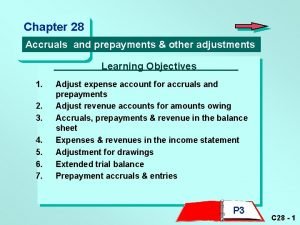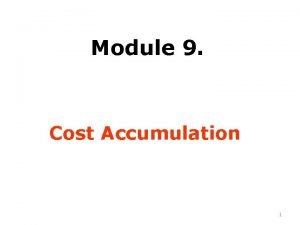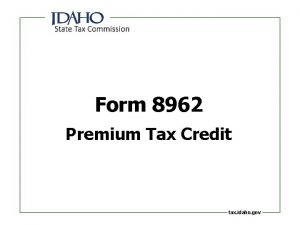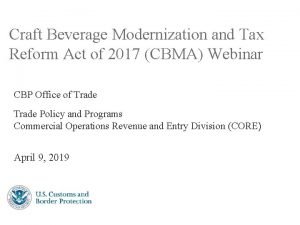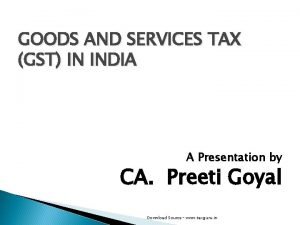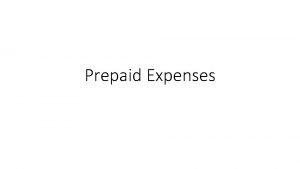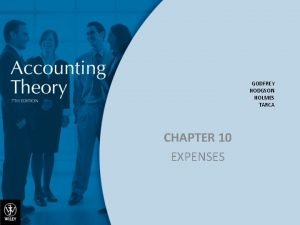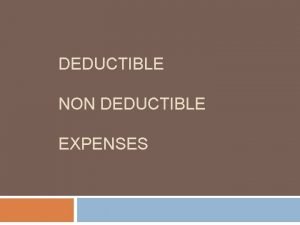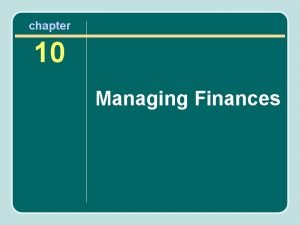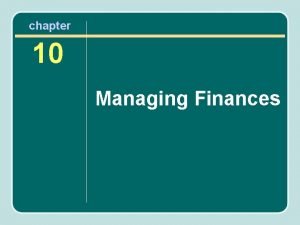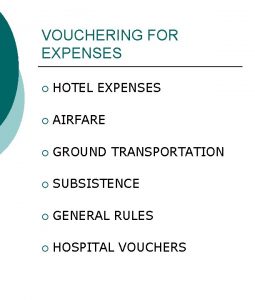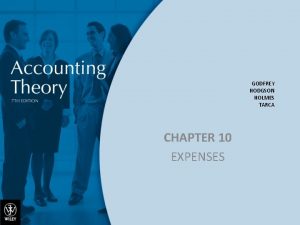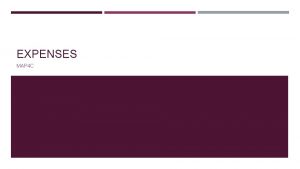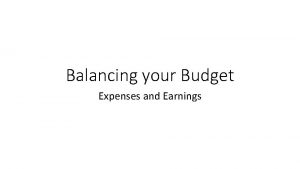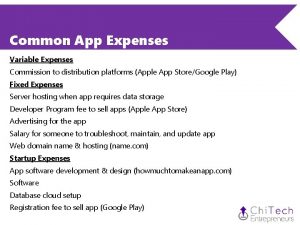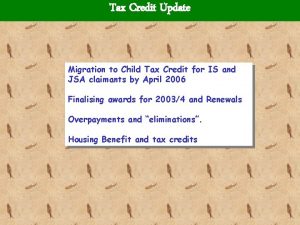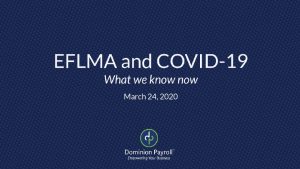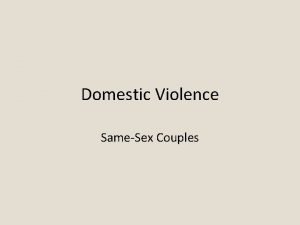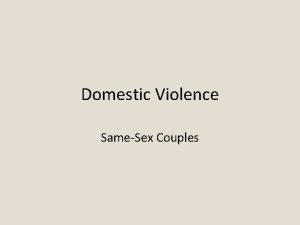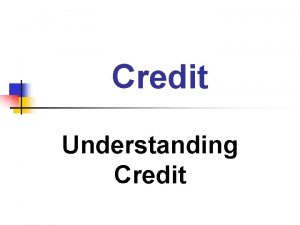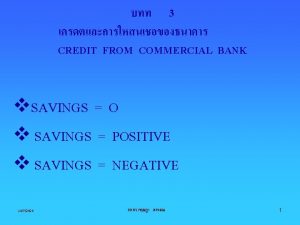Tax credit for domestic expenses What is tax
























- Slides: 24

Tax credit for domestic expenses

What is tax credit for domestic expenses? A direct credit subtracted from taxes – reduces the total tax you must pay – is given to each taxpayer personally Ø exception: the right to tax credit given to spouses § It allows you to deduct a part of the expenses caused by creditable work done in your home or second residence § The purpose is to encourage people to – maintain their homes – help combat the shadow economy – create gainful employment for others. 2 15. 9. 2020

What kind of taxpayers can get it? § Individual taxpayers – companies or organisations cannot get the credit § Estates of deceased individuals (for the year of death only) – only if the deceased individual had ordered the work in a manner that is binding before their death or if the work was begun when they were still alive § Shareholders of estates – if they live in a residence belonging to the estate and pay for the work done there 3 15. 9. 2020

What kind of work is creditable? § Basic cleaning and household work § Basic caregiving and nursing § Home maintenance and major repairs, installation of computer technology § The home or second residence where the creditable work is done must be in use by yourself, your parents or grandparents. 4 - The work can also be done in a care home, senior home or group home as long as the creditable work is done in a residence in use by yourself, your parents or grandparents. - Work done at the home or second residence of your spouse’s parents or grandparents is creditable, as well. 15. 9. 2020

What is basic work? § Work such as cleaning, cooking, laundry, yardwork, gardening or snow shovelling is considered basic cleaning and household work. § Work such as the washing, dressing, feeding and walking of or otherwise caring for children, the elderly or the disabled is considered basic caregiving and nursing. Basic caregiving and nursing may also include helping the person being cared for to visit the grocery store, bank or pharmacy if it is a part of other creditable work. Caregiving or nursing must be received by the person themselves or another person living in the same household. § Home maintenance and major repairs can include work such as repairs to the kitchen, bathroom or other rooms, electrical work, plumbing and cable work in a detached house, repairs to the cellar or sauna of a detached house, painting of an outbuilding or the installation of a security lock. 5 15. 9. 2020

What cannot be included? § Examples of work and costs that cannot be credited: – Other than basic cleaning and household work or basic caregiving and nursing work – Almost all payments going to a local town council – Work that has been paid for with a service voucher or other bond provided by social or health services – Costs of institutional care – Security services – Construction of new buildings, planning of construction projects – Work done at a location too far away from home, garden or backyard – In housing companies, any costs under responsibility of the central administration (not the private apartment/flat) § Work paid for by public subsidies or public support § You also cannot deduct: § – The part of an invoice relating to materials and travel expenses – The part of pension insurance, unemployment insurance collected from the worker Click here for a list of the usual types of household work: – 6 Frequent contract types 15. 9. 2020

How much credit are you allowed to have? You can receive credit for – 50% of the expense paid for work (when settling an invoice of a company or a self-employed professional) – 20% of the wages paid to an employee plus the required payroll contributions The credit has… – a maximum ceiling of € 2, 400 a year per taxpayer – a threshold of € 100 a year per taxpayer (taxpayer’s own liability) 7 15. 9. 2020

Year of payment = tax year of the credit § The credit is given for one calendar year at a time. § It is given the year when you paid – an invoice to a company or to a self-employed professional – wages to an employee 8 15. 9. 2020

Credit rights of spouses* § Maximum credit is € 2, 400 per individual taxpayer. Consequently, two spouses can get € 4, 800. § The credit is given to spouses according to the request they make on their tax returns. – The € 100 threshold is first subtracted from each. § If your paid expenses are below € 2, 400, it is advisable you request only one tax credit for just one of the spouses. – This way, the € 100 is not subtracted twice. § If one spouse asks for more than € 2, 400 to be credited, the Tax Administration transfers the unused amount to the other spouse. – The € 100 threshold is first subtracted from each. *Spouses (for tax purposes): two people who are married to or in a civil union with each other or live together and have or have had a common child 9 15. 9. 2020

When you settle an invoice § § Visit ytj. fi to check whether the company or self-employed professional is registered. – You cannot get the credit unless the party presenting the invoice is listed in the Prepayment Register – Exception: entity promoting for the public good* The invoice must have a specification – of the work expense (including VAT, if any) – of the materials, supplies, goods, etc. § You must keep the paid invoices/documentation for six years because your taxes may be audited. – Don't enclose them with the paper Tax Return! *Payment for basic household or care work done to an entity promoting for the public good qualifies for the credit even if ithe entity is not on the Prepayment Register. 10 15. 9. 2020

Maximum credit • You buy services where work is worth € 5, 000: or • you pay someone € 6, 250 in wages: Credit € 2, 400 for household 11 15. 9. 2020

Maximum credit § You buy services where work is worth € 5, 000. You are entitled to 50% of it (€ 2, 500) minus the own-liability threshold of € 100. This means that your total credit is € 2, 400 from the sum of your taxes. § If the gross wages you pay to a worker is € 6, 250 (approx. ), you get 20% credit equalling € 1, 250. Social expenses associated with the wages paid are creditable in full; in this example, they amount to € 1, 250 as they are 20% of gross wages. These two amounts make € 2, 500. However, you only get credit after the threshold of € 100. This means that your total credit is € 2, 400 from the sum of your taxes. § Both examples give you the maximum credit: € 2, 400 a year per individual taxpayer. 12 15. 9. 2020

Example: Home cleaning You pay a self-employed contractor € 60 a week for cleaning. Your expense is € 3, 120 for the entire year. You are entitled to € 1, 560 which is 50% of the part representing the work expense in this case. The € 100 threshold is subtracted. This means that your total credit is € 1, 460 from the sum of your taxes. – 13 • € 60 x 52 = € 3, 120 € (cleaning service for the whole year) • € 3, 120 x 0, 50 = 1560 € (the creditable part) – € 1, 560 − € 100 = € 1, 460 (the remainder after you subtract the threshold) – € 3, 120 (expense for the entire year before credit) - € 1, 460 = € 1, 660 (expense for the year after credit) – € 1, 660 (net expense): 52 (number of weeks cleaned) = € 31. 90 (net expense for one week of cleaning after credit) If you continue with the cleaning contract, it is important to check whether the company or selfemployed contractor is listed in the Prepayment Register. 15. 9. 2020

How to apply 1. By having the creditable expenses included in your tax card 2. Requesting the credit through Palkka. fi 3. Requesting the credit when you complete your tax return 14 15. 9. 2020

What information you must have at hand § You cannot get the credit unless you have – the Business ID and address of the company § that did the work and sent you an invoice – Personal details and address of the worker § if you employed someone & paid wages – Invoice showing the dates of work/payment; pay slip proving wages paid out (or photocopy) 15 15. 9. 2020

1. Requesting a revised tax card § Make a new tax card online at tax. fi/taxcard. • Enter the household expenses under “Credits for the tax due”. • Alternatively, you can use the telephone service or visit the local tax office. • You can already use the credit during the year of payment. • You do not need to fill in the same expenses on your pre-completed tax return. • To practice, launch the demo. 16 15. 9. 2020

2. Requesting the credit through Palkka. fi • You can enter expenses via the palkka. fi e-service until the end of January the following calendar year. • The tax credit is displayed on your pre-completed tax return. • You can also use palkka. fi to report payroll information. • To practice, launch the demo. 17 15. 9. 2020

3. Requesting the credit when you complete your tax return • Complete your pre-completed tax return in the Spring online at tax. fi/taxreturn • or fill in the paper form and enclose with it Form 14 A or 14 B. • To practice, launch the demo. 18 15. 9. 2020

If you forget to enter the credit on your tax return § It is not too late to seek adjustment after the statutory tax assessment period has passed. – Fill out a claim form and file it to the Board of Adjustment, Form 3308 e. . – You can claim adjustment for the tax year 2016 or five years previous (counting from the beginning of the year following the end of taxation). From the tax year 2017 onwards, claims for adjustment must be made within three years from the beginning of the year following end of the tax year. Read more about claims for adjustment. . 19 15. 9. 2020

Hiring an employee Once you start paying wages to an employee, you must also fulfill all necessary employer obligations. § File an Employer Payroll Report to the Tax Administration, detailing the total wages and the withholding, – if you pay more than € 200 a year to an individual employee. § File the report immediately when the employment contract ends – or by the end of January the following year. § File the report online – at palkka. fi or with Form 7801 e. 20 15. 9. 2020

Pay levels determine your obligations List of employer obligations: • Withholding tax • Employer’s health insurance contributions • Unemployment insurance contributions • Pension and accident insurance contributions • Periodic tax returns on employer contributions • Annual information returns 21 15. 9. 2020 If you pay less than € 1, 500 / year / person, you can leave out these: • Withholding tax • Employer’s health insurance contributions • Periodic tax returns on employer contributions If your employee wants you to withhold tax on a gross income of less than € 1, 500 a year, you can only leave out the employer’s health insurance contribution. If you pay less than € 1, 200 / year in total, you can also leave out these: • Unemployment insurance contributions • Accident insurance contributions

Preparing a pay slip for your employees § The law requires you to hand out pay slips listing the following information: – employer's name, personal identity code, address and telephone – employee's name, personal identity code and address – start date of employment, work hours and basis for pay – amount of gross wages and the amount withheld on it – fringe benefits and expense coverage – payment date – pension and unemployment insurance contributions withheld from the employee – amount of the health insurance contribution § Keep copies of the payslips for 6 years after the end of the year the wages were paid. 22 15. 9. 2020

Read more about hiring an employee § Articles on tax. fi: – Kotitaloustyönantajan maksut ja ennakonpidätys vuonna 2016 (in Finnish and Swedish only) § information about the obligations you have and payments you must make if you hire an employee – Filing and paying employer contributions ‒ households § information about the withholdings and health insurance contributions you must pay in My. Tax when you pay an employee wages with taxes wittheld § Visit the palkka. fi service 23 15. 9. 2020

Further guidance § tax. fi – Visit the Answer Bank – Telephone service § Run the demo versions: – Tax Card Online – Palkka. fi – Tax Return on the Web § Check if a business operator is listed in the prepayment register: ytj. fi 24 15. 9. 2020
 Accrued expenses meaning
Accrued expenses meaning What is cost accumulation
What is cost accumulation This can be avoided by giving credit where credit is due.
This can be avoided by giving credit where credit is due. Input tax credit meaning
Input tax credit meaning Historic tax credits 101
Historic tax credits 101 Historic tax credit structure diagram
Historic tax credit structure diagram Historic tax credit syndication
Historic tax credit syndication Form 8962 premium tax credit
Form 8962 premium tax credit Cbma tax credit
Cbma tax credit Ey r&d tax credit
Ey r&d tax credit Tusd tax credit
Tusd tax credit Combining new markets and historic tax credits
Combining new markets and historic tax credits Ohfa mortgage tax credit
Ohfa mortgage tax credit Wotc tax credit calculation chart
Wotc tax credit calculation chart Utah historic preservation tax credit
Utah historic preservation tax credit Solidarity tax credit eligibility
Solidarity tax credit eligibility Community investment tax credit tennessee
Community investment tax credit tennessee Michigan historic tax credit
Michigan historic tax credit Direct tax and indirect tax
Direct tax and indirect tax Ralphs annual income is about $32 000
Ralphs annual income is about $32 000 Blomman för dagen drog
Blomman för dagen drog Ekologiskt fotavtryck
Ekologiskt fotavtryck Bris för vuxna
Bris för vuxna Redogör för vad psykologi är
Redogör för vad psykologi är Bästa kameran för astrofoto
Bästa kameran för astrofoto
